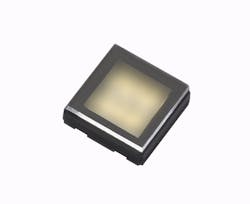Osram Opto Semiconductors has announced the Synios P2720 CR series of LEDs for rear-facing automotive applications such as fog lights with a phosphor-conversion approach delivering greater output at high-temperature conditions common in automotive-lighting cavities. Plessey Semiconductors has announced that it added passive-matrix micro LED displays to the Data-Vµ product family. Everlight Electronics has announced new ELUC3535NUB LEDs that radiate in the UV-C (100–280 nm) band and that can be used in disinfection applications. Seoul Semiconductor claims assert that coronavirus drives increased interest in ultraviolet (UV) LEDs.
Automotive lighting
The Osram automotive-centric LED reminds us that there are diverse approaches to color LEDs that can be matched to application requirements. We covered such technologies and applications in a feature article a couple of years ago on color LEDs. In automotive applications, monochromatic color LEDs are used most often, but Osram found a specific reason to use phosphor conversion in the Synios P2720 CR — with the CR standing for converted red.
LEDs in exterior automotive applications are operated at relatively high drive currents which in turn minimizes the number of LEDs required to implement any specific function such as fog lights. Moreover, fog lights operate for extended periods unlike turn or braking indicators. The combination of high currents and extended operating time result is high temperature at the semiconductor junction.
Meanwhile, the compound semiconductor materials used in monochromatic red LEDs exhibit losses in output of up to 50% at operating temperatures in the 60–70°C range. The blue-pump LEDs used in phosphor converted designs do not suffer such severe output losses thus the Osram decision to utilize phosphor-converted red.
The Synios P2720 CR LEDs are integrated in a 2×2.7×0.6-mm package. There are two versions of the LED, one with 49 lm nominal output and the other with 103 lm nominal output. As you can see in the nearby photo, the phosphor coating has an unexpected shape. Seeing that photo led us to suspect that there may have been multiple emitters in the package, especially when Osram stressed the case for multi-functional lights in automotive applications. But there is in fact only one emitter and the additional phosphor covers the portion of the package cavity where wire bonds exit the package.
Micro LEDs
Moving to emerging micro LEDs, Plessey continues to push its monolithic approach to building displays with such technology. Using wafer-level technology enables the monolithic manufacturing scheme but for now essentially limits displays to monochromatic operation. The new passive-matrix displays feature 48×36-pixel resolution targeted at augmented reality (AR) and what Plessey calls mixed-reality applications.
The displays are manufactured using Plessey’s gallium-nitride-on-silicon (GaN-on-Si) technology and the company said it has technology that will enable color displays. “Micro LED displays are now the go-to technology for next-generation developments requiring power-efficient and ultrabright displays,” said Leon Baruah, Plessey’s senior micro LED product sales manager. “With the introduction of our Data-Vµ passive-matrix displays, applications where dynamic content needs to be displayed in a small form factor that is outdoor readable without compromising on battery life has become reality.”
UV LEDs and disinfection
Moving to ultraviolet (UV) LED technology, Everlight’s new 280-nm devices can kill pathogens and is packaged in inorganic quartz glass, enabling mounting in contact with water or other liquids. The company announced versions of the LED in 2-, 10-, and 30-mW packages. Everlight says the products can be used for water purification and sterilization of surfaces. We have covered such applications several times previously, including the ability for UV-C to sterilize running water.
Everlight did not mention the outbreak of the coronavirus in its press release. Presumably, UV-C energy would kill such a pathogen. Seoul Semiconductor has asserted that it has seen an uptick in customer inquiries relative to the company’s violeds products that it attributes to the spread of the coronavirus







